Intermarkets' Privacy Policy
Donate to Ace of Spades HQ!
aceofspadeshq at gee mail.com
Buck:
buck.throckmorton at protonmail.com
CBD:
cbd at cutjibnewsletter.com
joe mannix:
mannix2024 at proton.me
MisHum:
petmorons at gee mail.com
J.J. Sefton:
sefton at cutjibnewsletter.com
'Twas the Day After Christmas Cafe
Roundabout Open Thread
Tree Mansion Open Thread
Hedgehog Hospital Open Thread
Jetpack Transfer Open Thread
The Most Played Movies on HBO During the 80s Open Thread
Skiing Mount Everest Open Thread
THE MORNING RANT: We Should Cheer for Bari Weiss to Fail in Her Effort to Rehabilitate CBS’ Reputation
Mid-Morning Art Thread
Jim Sunk New Dawn 2025
Jewells45 2025
Bandersnatch 2024
GnuBreed 2024
Captain Hate 2023
moon_over_vermont 2023
westminsterdogshow 2023
Ann Wilson(Empire1) 2022
Dave In Texas 2022
Jesse in D.C. 2022
OregonMuse 2022
redc1c4 2021
Tami 2021
Chavez the Hugo 2020
Ibguy 2020
Rickl 2019
Joffen 2014
maildrop62 at proton dot me
TBD
Saturday Gardening Thread: Butterflies Are Free and Other Stuff [Y-not, KT, and Weirddave]
Y-not: Good afternoon, Gardeners!
Inspired by KT's description of the butterfly-friendly milkweed plant, today's thread is brought to you by Puccini's Madame Butterfly which premiered in 1904:
Set in Nagasaki, Japan, Madame Butterfly told the story of an American sailor, B.F. Pinkerton, who marries and abandons a young Japanese geisha, Cio-Cio-San, or Madame Butterfly. In addition to the rich, colorful orchestration and powerful arias that Puccini was known for, the opera reflected his common theme of living and dying for love. This theme often played out in the lives of his heroines -- women like Cio-Cio-San, who live for the sake of their lovers and are eventually destroyed by the pain inflicted by that love. Perhaps because of the opera's foreign setting or perhaps because it was too similar to Puccini's earlier works, the audience at the premiere reacted badly to Madame Butterfly, hissing and yelling at the stage. Puccini withdrew it after one performance. He worked quickly to revise the work, splitting the 90-minute-long second act into two parts and changing other minor aspects. Four months later, the revamped Madame Butterfly went onstage at the Teatro Grande in Brescia. This time, the public greeted the opera with tumultuous applause and repeated encores, and Puccini was called before the curtain 10 times. Madame Butterfly went on to huge international success, moving to New York's Metropolitan Opera in 1907.
If at first you don't succeed...
Take it away, KT:
Personal Gardening Update:
We got a little bit of rain! Yay! Later, a strange storm cell came through with sudden wind, lightning and maybe some hail nearby but no rain for us. It reminded me that there were some REAL storm cells in other parts of the country. Hope everybody's garden made it through the storms.
Last year at this time, we had ripe Apriums on the tree. This year, they are just starting to color. I need to do more thinning of stone fruits. We are starting to see spider mites, despite the somewhat cooler (than last year) weather the past month. Spider mites were a real problem last year.
I picked my first ripe Sungold tomato. Very nice flavor. Skin was a little tough, but that is to be expected in the first tomatoes of the year. The tomato plants look happier than our tomato plants the last couple of years. We planted them in a different location, so rotation may have helped. We also planted earlier.
I had fun with the Garden Train video that Beverly linked in the comments a couple of weeks ago. I thought it was worth featuring today in case you missed it.
If you are in the North and haven't planted potatoes yet, Maggie's Farm recently posted a link on The Right Potato for the Job. I like waxy potatoes for roasting and steaming. And I like yellow-fleshed potatoes. How about you?
Choose your next weeds carefully...
We are currently trying to eradicate weeds that we did not choose. But there are certain weeds that gardeners DO choose to plant. One kind of weed that a lot of people are planting right now is milkweed. Some people may love their future weeds. Other people, or their neighbors, may come to hate certain weed choices. I kinda promised Stace I would do a little milkweed summary.
I was fascinated with milkweed as a child. I saw little striped Monarch caterpillars grow on the leaves, turn into lovely pupae, then hosta into gorgeous butterflies. "By the time the caterpillar is half an inch long its butterfly wings are already developing inside it."
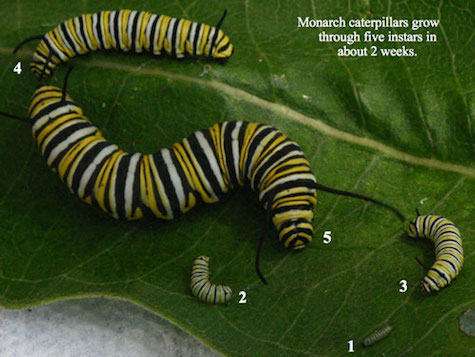
My interest in milkweed increased when my mother devised for me a rather elaborate craft project involving exotic things like India ink, fountain pens, blotting paper, watercolors and silky milkweed floss. She gathered the floss from roadside plants.
I also learned that during WWII, milkweed floss was gathered by schoolchildren as a replacement for kapok, for life jackets and such. I didn't really know what kapok was at the time, though my father had an old life jacket filled with it in the basement. It seemed heavier to me than milkweed floss would have been. Of course, seeds carried on the wind by airy floss contribute to the invasiveness of some species of milkweed.

I once worked on a corporate campus in Southern California where a Silk Floss Tree was planted. The Silk Floss tree is a cousin to Kapok and Baobab trees. I watched that Silk Floss tree release floss into the wind when the seed pods matured. It reminded me of milkweed floss and cottonwood trees. Before the floss starts to fly, the flowers provide nectar to Monarch butterflies. The flowers are very interesting close-up, and a tree full of them is gorgeous.
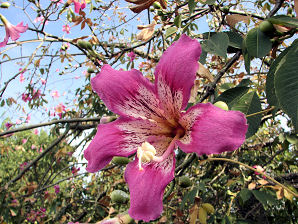
Silk Floss trees will grow in desert areas such as Glendale, Arizona. They make a good tree for a xeriscape in nearly frost-free climates. The trunks and branches are green when young so that photosynthesis can continue when the tree loses its leaves. They are covered with conical prickles that store water for dry times.
TRIGGER WARNING: One traditional name for the tree is the "wife-beater tree". Somewhere in Argentina or Brazil, people may recount an unpleasant legend to explain this name. I am not particularly interested in hearing it.

But back to milkweed: There are more than 70 species of milkweed in the USA, plus a few plants in the same genus that attract egg-laying Monarch butterflies. Below, some notes on a few of them. I look forward to updates on your choices for attracting butterflies and/or raising caterpillars.
Common Milkweed, Asclepias syriaca
Common Milkweed may be the most frequent host of Monarch caterpillars in the Northeast, and its native range includes much of the USA east of the Rockies. Milkweed flowers provide lots of nectar for insects, but sometimes trap visiting honeybees between their anthers. Native bees and wasps have an easier time escaping.
We were taught in school that toxic compounds in milkweed deterred birds from eating Monarch butterflies. Look-alike Viceroy butterflies were supposed to be protected by their similarity to Monarchs. But it now looks like there may be some mutual mimicry going on.
Not all species of milkweed contain the same amount of the cardiac glycosides which can make birds sick, and which, in large doses, can be dangerous to people. Many people maintain that Common Milkweed is edible without special treatment. This would indicate a low level of cardiac glycosides. But in some locales, the same plant parts are bitter and inedible. This may be due to hybridization with other species of milkweed.
The "Eat the Weeds" guy provides a lot of interesting information for plant nerds, wild food enthusiasts and survivalists here. "I would not try any milkweeds with skinny leaves." for example. He explains why common milkweed is called "syriaca" even though it is not from Syria. He explains how to tell milkweed and dogbane apart. As suggested by the name, dogbane is generally toxic to animals. Monarchs sometimes lay eggs on it.
Farmers tend to react with dismay when organizations encourage people to plant Common Milkweed. It is an aggressive plant where adapted, and hard to get out of fields. Stems may pop up many feet from the original plant.
Part of the push to plant milkweed comes from anti-Monsanto alarmists. But planting Common Milkweed anywhere near a farm just makes it more likely that a farmer will need to use herbicides. If you have this plant or similar invasive milkweeds growing on your property and want to keep them, remove the seedpods before they release seeds. To keep the neighbors happy.

Asclepias tuberosa, Butterfly Weed
Butterfly Weed is much less invasive than Common Milkweed. In fact, it may be a challenge to get it established. It is a tap-rooted plant, suited to well-drained, sandy soils. High Country Gardens sells a cultivar that does better in clay soils than the species. It resents transplanting. Some people report good success with winter-sowing and careful transplanting when the plants are young.
It also comes up late in the spring after its winter dormancy, and people accidentally dig it up. Some gardeners plant daffodils or other spring bulbs nearby to remind them not to dig up the butterfly weed. Daylilies are another good companion. This plant does best in full sun. Plant it in large swaths to attract butterflies seeking nectar. This is a good milkweed for cut flower use, as the stems do not exude latex. No pretreatment of stems is required before arranging.
The species is generally seen in a bright orange color that may not fit well into all color schemes. You can get seeds for a mixture of hot colors. As I recall, the "Gay Butterflies" mixture used to include pink and cream, and perhaps a bronze-leaved red. Springhill may be using an old photo that includes these colors, but their description now says, "shades of orange, red and yellow". There is also a yellow selection called "Hello Yellow". Below, the classic orange Butterfly Weed, dramatically paired with blue:
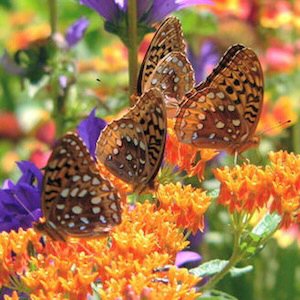
Swamp Milkweed, Asclepias incarnata
This one is easy to grow, and may be invasive in certain situations, but not like Common Milkweed. Because it is more attractive to egg-laying Monarchs than Butterfly Weed, one strategy for a butterfly garden might be to plant some Swamp Milkweed in self-watering containers away from the larger plantings of Butterfly Weed, which is very attractive to butterflies for its nectar. Mama butterflies may prefer isolated plants for egg laying because this may lessen the chance of caterpillar predators finding her babies.
There are several garden cultivars available. "Ice Ballet" and "Milkmaid" are white. "Cinderella" is pink and "Soulmate" is rose.
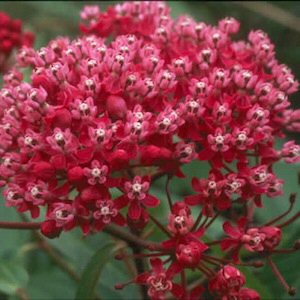
Milkweed Vine, Morrenia odorata
This vine, now naturalized in parts of Florida, is in the same family, but not the same genus, as milkweed. It has some similarities, but the "Eat the Weeds" guy is actually enthusiastic about eating this one. He calls it his "civic duty", since it is damaging to citrus groves. Its other common name is "Strangler Vine". Though people can enjoy eating this plant, it is toxic to cattle.
Monarchs will lay eggs on it in a pinch, though they seem to prefer real milkweed. Edible "Strangler Vine" should not be confused with the "Dog-Strangling Vine". This is a nasty one, an invader now even found in Canada. Monarchs lay eggs on it, but it kills a large percentage of the caterpillars. It also strangles plants and trees. Rip it out, but don't eat it.
Another species to avoid is the Horsetail or Poison Milkweed. Only two or three ounces can kill a sheep. In an open field, most animals have the good sense not to eat it. But in cut hay, it can be deadly.
Tropical Milkweed, Asclepias curassavica
Tropical Milkweed, or Blood Flower, may be the ultimate Monarch caterpillar host. It can be grown as an annual in the North, but may naturalize in the South.
There is now a controversy among plant nativists around growing it in subtropical areas because some Monarchs are staying in those areas of the USA permanently, rather than migrating. There is also a concern about the possible spread of a butterfly disease through close contact between butterflies on the plants. One sensible idea from Texas: Tropical Milkweed is OK for Monarch Butterflies, "Just Cut the Dang Stuff Down".
There is a florist-quality series of cultivars called the "Silky Series". Silky Gold and Silky Deep Red seem to be popular. Don't get the latex in your eyes.
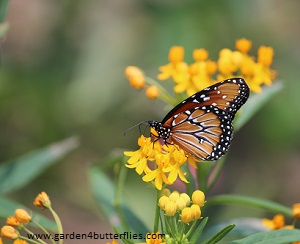
Other Monarch Hosts
This site has a brief rundown on several plants you might choose if you wish to stick with native species, or if you want to grow a milkweed tree. Or if you want to shock those prudish neighbors by growing Bishop's Balls. White Milkweed is fairly shade tolerant, and Green Milkweed may be tolerant of moist or wet clay soils. Whichever one you choose, have fun in your butterfly garden.

Y-not: Thanks, KT!
Butterflies are amazing creatures. They're beautiful, for one thing.
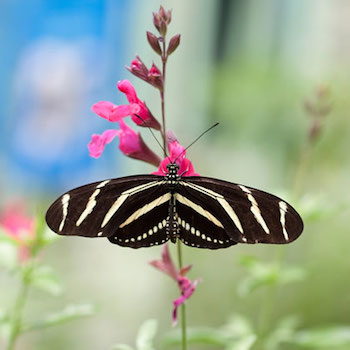
But they are also a great case study to use when arguing a pro-life position.
FOLLOW THE LINK ABOVE. THIS ONE HERE. YES, THIS LINK.

I think the transformation of the (often) homely and destructive caterpillar into a beautiful and useful butterfly also reminds us that we have to take the bad with the good.
If you want to learn all there is to know about butterflies (on this continent) you might want to check out the Entomological Society of America or the North American Butterfly Association. NABA runs the National Butterfly Center in Mission, Texas. Ever been there?
Or, if you're of a more scientific bent, how about a REAL closeup of a butterfly wing?
A butterfly's iridescent coloring is a result of the intricate patterning of thousands of microscopic scales, attached to thin wing membranes. Those scales scatter light in complex ways. Iridescence helps butterflies elude predators.

Each complex scale is made up of about 40 ribs, the ribs are connected by tiny cross bars.
For a sense of scale, the yellow line below the scanning electron micrograph image is about 20 microns. A human red blood cell is roughly 8 microns in diameter.
The ribs are held apart by intricate crossbars. Air spaces also affect light absorption and refraction. Butterfly scales are composed of stacked chitin lamellae. Chitin is a tough, semitransparent substance that is the main component of the exoskeletons of arthropods, such as the shells of crustaceans and the outer coverings of insects. Chitin is also found in the cell walls of certain fungi and algae.
A Butterfly scales' structural grid diffracts or bends light in different degrees and that interference is what gives butterflies their intensity of color, vibrancy and iridescence. When light hits the complex wing, the multiple reflections compound one another, such as when light hits a scale, that ray of light also interacts with light bouncing off the scale, in this case from numerous differing angles. These compound interactions create iridescence and variety of color.
Butterfly wings receive their color from two sources, from structural color (described above) and ordinary (or pigmented) color. Butterfly scales are also pigmented. Most brown and yellow butterflies get their color from melanin, just like you and I. Even Blue Morphos have a base of melanin. Melanin absorbs light which helps to further intensify a butterfly's coloration. Other coloring agents are uric acid (white), carotenoid pigments (orange) and flavonoids such as quercetin (red and purple).
This article from Wired explains more about the origins of the shine in butterfly wings, including a short video explaining how a particular butterfly's wings get their blue color:
The Wired article also talks a bit about how butterfly wings develop during the organism's metamorphosis:
Two kinds of cells are involved; scale cells and socket cells. In a caterpillar, they are just ordinary cells, and don't have any distinguishing characteristics. But early on in pupal development (7% complete), they begin to organize in rows corresponding to where the future wing will grow. Each butterfly scale is the product of a single scale cell.
The socket cell anchors the scale to the membrane of the insects' wing; the scale cell pokes through the insect's wing surface like a hernia. The scale cell forms strings of proteins called F-actins, which provides a framework on which the detailed nanostructures of the scales are built. At 28% complete metamorphosis, you can see both cells and ribbed bundles of actins forming. It's a ghostly outline of the scale structure to come.
Like a pasta maker, the scale cell squeezes out and assembles a lattice of actins. These actins form the template on which the rest of the scale's cuticle will be laid down, and foreshadow the fine ribs of the finished scale. At around 64% of the way through metamorphosis, the actin bundles begin to disappear, and the finishing touches are added to the scale. Eventually, the scale cell dies, revealing the finished scale which hardens upon emergence.
One correction to the text. The protein molecule that builds the long struts is called G-actin (for globular actin), not F-actin. G-actin is a round(ish) molecule, roughly 5 nanometers in diameter, that self-assembles into long actin filaments (F-actin). There are a battery of protein molecules and other chemical factors that regulate the assembly and disassembly of actin filaments in all of your cells and, as it turns out, in butterfly wings.
Biology is cool.
Small biology is really cool.
Really small biology is...
Now, here's Weirddave:
This year I didn't plant as many vegetables as last year, I mostly just planted the front part of the beds, but everything is in the ground and established, so lets take a look, shall we? First up: bush beans. Now, I've never planted bush beans before, I expected them to look more like, I dunno, a bush. Some of them do, but a lot of them are just flopping on the ground.
The straws you see were my attempt to repair some of the stalks. I planted them too early, and a lot of them grew so tall in their seedling pots that they couldn't support themselves and they flopped over. I took some straws from McDonalds, cut them, split them lengthwise, and then put them around the creased stem like a splint. Results are mixed, I'll keep you posted.
Next, we have the Teutonic bed. Everything is neat and orderly, all plants lined up in ranks, as they should be:
That's three different types of lettuce in front, then broccoli, then Brussels sprouts. I don't know if the broccoli or sprouts will make it, they went in late so they will likely bolt. On the other hand, I had a fire in the fireplace just this week, so maybe the summer will be cool. In the background you can see a few snap peas struggling to grow up the side of the deck.
Finally we have tomatoes and peppers. My job today is going to be staking these plants up, because they are already producing:
There at least I think I will be enjoying fresh tomatoes before too long. Finally, a report on those miracle grow seed pods I talked about a few months back. All 4 of them grew well, here's the pot I planted them in:
L to R we have pepper, tomato, pepper, tomato. The tomato that is second from the left was not grown from a pod-I grew a green beans pod there and it's already been transplanted to the garden. The other three plants are from the pods, so while they aren't cost effective compared to just buying seeds, they all grew well.
Y-not: And now for something completely different, here's Iron Butterfly:
I think the 60s are proof-positive that drugs are bad for you. (Sure, they claim that it was wine that caused "In the Garden of Eden" to come out as gibberish, but the audiences who listened to this dreck were definitely on something stronger.)
Speaking of hippies, here's Goldie Hawn in her undies from the movie Butterflies Are Free:
What's happening in your gardens this week?
**Post updated to point out the pro-life link.**
BeckoningChasm: "Hello Horde. Love the heck out of you all. Watch ..."
Braenyard - some Absent Friends are more equal than others _ : "WD, good to see you but glorifying physical adulte ..."
Robert, The Love Walrus: "This is a bold ONT. ..."
Robert, The Love Walrus: "Evening. So in hometown news there was an offic ..."
Robert, The Love Walrus: "Evening. So in hometown news there was an offic ..."
COMountainMarie : "And I'm never first...oh well.. ..."
Rev. Wishbone: "Yes but the real question is, was Die Hard a Star ..."
Blonde Morticia: " I really was first. ..."
clarence: "berry, berry bold. ..."
San Franpsycho: "Good evening morons e grazie wd ..."
Blonde Morticia: "e5vhbe5he5be ..."
'Twas the Day After Christmas Cafe
Roundabout Open Thread
Tree Mansion Open Thread
Hedgehog Hospital Open Thread
Jetpack Transfer Open Thread
The Most Played Movies on HBO During the 80s Open Thread
Skiing Mount Everest Open Thread
THE MORNING RANT: We Should Cheer for Bari Weiss to Fail in Her Effort to Rehabilitate CBS’ Reputation
Mid-Morning Art Thread
Paul Anka Haiku Contest Announcement
Integrity SAT's: Entrance Exam for Paul Anka's Band
AllahPundit's Paul Anka 45's Collection
AnkaPundit: Paul Anka Takes Over the Site for a Weekend (Continues through to Monday's postings)
George Bush Slices Don Rumsfeld Like an F*ckin' Hammer
Democratic Forays into Erotica
New Shows On Gore's DNC/MTV Network
Nicknames for Potatoes, By People Who Really Hate Potatoes
Star Wars Euphemisms for Self-Abuse
Signs You're at an Iraqi "Wedding Party"
Signs Your Clown Has Gone Bad
Signs That You, Geroge Michael, Should Probably Just Give It Up
Signs of Hip-Hop Influence on John Kerry
NYT Headlines Spinning Bush's Jobs Boom
Things People Are More Likely to Say Than "Did You Hear What Al Franken Said Yesterday?"
Signs that Paul Krugman Has Lost His Frickin' Mind
All-Time Best NBA Players, According to Senator Robert Byrd
Other Bad Things About the Jews, According to the Koran
Signs That David Letterman Just Doesn't Care Anymore
Examples of Bob Kerrey's Insufferable Racial Jackassery
Signs Andy Rooney Is Going Senile
Other Judgments Dick Clarke Made About Condi Rice Based on Her Appearance
Collective Names for Groups of People
John Kerry's Other Vietnam Super-Pets
Cool Things About the XM8 Assault Rifle
Media-Approved Facts About the Democrat Spy
Changes to Make Christianity More "Inclusive"
Secret John Kerry Senatorial Accomplishments
John Edwards Campaign Excuses
John Kerry Pick-Up Lines
Changes Liberal Senator George Michell Will Make at Disney
Torments in Dog-Hell
The Ace of Spades HQ Sex-for-Money Skankathon
A D&D Guide to the Democratic Candidates
Margaret Cho: Just Not Funny
More Margaret Cho Abuse
Margaret Cho: Still Not Funny
Iraqi Prisoner Claims He Was Raped... By Woman
Wonkette Announces "Morning Zoo" Format
John Kerry's "Plan" Causes Surrender of Moqtada al-Sadr's Militia
World Muslim Leaders Apologize for Nick Berg's Beheading
Michael Moore Goes on Lunchtime Manhattan Death-Spree
Milestone: Oliver Willis Posts 400th "Fake News Article" Referencing Britney Spears
Liberal Economists Rue a "New Decade of Greed"
Artificial Insouciance: Maureen Dowd's Word Processor Revolts Against Her Numbing Imbecility
Intelligence Officials Eye Blogs for Tips
They Done Found Us Out, Cletus: Intrepid Internet Detective Figures Out Our Master Plan
Shock: Josh Marshall Almost Mentions Sarin Discovery in Iraq
Leather-Clad Biker Freaks Terrorize Australian Town
When Clinton Was President, Torture Was Cool
What Wonkette Means When She Explains What Tina Brown Means
Wonkette's Stand-Up Act
Wankette HQ Gay-Rumors Du Jour
Here's What's Bugging Me: Goose and Slider
My Own Micah Wright Style Confession of Dishonesty
Outraged "Conservatives" React to the FMA
An On-Line Impression of Dennis Miller Having Sex with a Kodiak Bear
The Story the Rightwing Media Refuses to Report!
Our Lunch with David "Glengarry Glen Ross" Mamet
The House of Love: Paul Krugman
A Michael Moore Mystery (TM)
The Dowd-O-Matic!
Liberal Consistency and Other Myths
Kepler's Laws of Liberal Media Bias
John Kerry-- The Splunge! Candidate
"Divisive" Politics & "Attacks on Patriotism" (very long)
The Donkey ("The Raven" parody)

